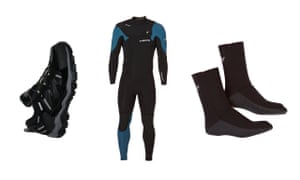When I was a kid, I used to jump off the old harbour wall in Fishguard, Pembrokeshire, with my friends. It was around four metres high and was a bit of an adrenaline rush, though we made sure there were no boats around. After that we progressed to the coastline, exploring cliffs, jumping a little bit higher and daring each other to go further. This was similar to coasteering, but I didn’t realise that until I went on a school trip and tried it.
I loved it then and I still do. I always describe it as everything you’re not really allowed to do at the beach. It’s grappling with the coastline in a way that you can’t do in a boat or from the shore, getting from A to B but in an exciting way: traversing rocks, looking into caves, jumping into the sea from various heights and playing around in the water. But you need to have a guide who knows what they’re doing and whose local knowledge makes it safe; I’m now a guide myself.
The cliff-top paths in Pembrokeshire are very dramatic, but coasteering gives you a different view; we see everything from sea level. As an adventure activity, coasteering can be dangerous, but knowing the area and the conditions reduces the risk. You have to know about riptides, the waves and water depths, as well as the rocks you can’t see from above the surface.
I still go out on my own or with friends after work, so we can do our own thing. I’ll find new areas where you have to think more about what’s safe and assess the dangers; I get more of a buzz when I’m doing bigger and scarier stuff. I wouldn’t want a desk job – the coast is my office, and it’s not a bad place to be.
My weekend workout
Favourite place for coasteering The Blue Lagoon and Abereiddy in Pembrokeshire – it’s a lovely beach with an old slate quarry nearby.
Favourite snack Porridge and a banana before, ice-cream and a cup of tea after.
How often do you go coasteering? I’m out most days as a guide but twice a week it’s for fun, searching for bigger jumps and harder climbing.
Five ways to get started
1 Do your research to find a decent coasteering company whose guides are experienced in first aid and have lifesaving qualifications. Never go out alone.
2 Be open-minded. Often there’s an, “Oh my God, what am I doing?” feeling at first, but stick with it. After the first couple of jumps, everyone starts to enjoy it.
3 Don’t worry about the weather. Coasteering is all-weather; we’ve cancelled only four sessions in the last seven years because it was too rough. Even if you don’t venture into the sea, there’s always exploring among the rocks where it’s more sheltered.
4 Most coasteering companies provide equipment, but some basic kit is useful. A decent wetsuit is vital whatever the weather; it offers an extra layer between your body and rockier surfaces. Good footwear, especially a pair of old running shoes, will come in handy.
5 Choose the right place. Anywhere with a rugged coastline and miles of beaches is a good place to start: Wales, Devon, Cornwall and the north-west coast all have coasteering activities on offer.
• For more details, go to celticquestcoasteering.com
Essential kit

• Do you have a passion for exercise? Send your story to [email protected]
Source: Read Full Article
